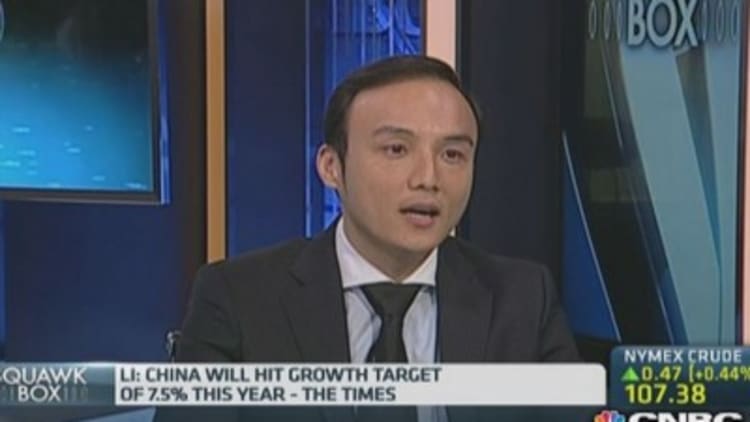
The tightly managed Chinese yuan, which recorded its biggest weekly jump in 2½ years last week, is set to continue on its appreciation path for the remainder of the year as the economy begins to stabilize, say strategists.
"The PBoC (People's Bank of China) has sent a strong message - through much stronger midpoint fixings over the course of last week – that it doesn't want further depreciation of the currency. It would like a period of stability going forward," Khoon Goh, senior foreign exchange strategist at ANZ told CNBC on Monday.
"This is a reflection that authorities are more comfortable with how the economy is faring," he said.
Read MoreFrom weak to strong: China's yuan changes track
A slew of data from China last week provided fresh signs that the world's second-largest economy is stabilizing, aided by targeted stimulus measures from Beijing.
May retail sales, for example, rose 12.5 percent on year, above analyst expectations for a 12.1 percent increase. Fixed asset investment rose 17.2 percent on year for the January-to-May period, just above expectations for a 17.1 percent rise.
Goh forecasts the currency will see a period of stability followed by modest appreciation in the second-half. He expects it will strengthen to 6.15 by year-end – an almost 1 percent rise from current levels.
Changing course after months of depreciation, the yuan gained around 0.5 percent against the U.S. dollar last week as the PBoC guided the currency higher with stronger midpoint settings. The central bank tightly controls the yuan's movement by fixing a daily midpoint from which it can rise or fall by 2 percent.
Recent appreciation marks a shift away from earlier this year when the central bank engineered sharp yuan depreciation to shake out speculators betting on one-way appreciation and provide support to the export sector.
The PBoC fixed the yuan's mid-point at 6.1537 versus the dollar on Monday, slightly weaker than Friday's mid-point of 6.1503, but stronger than the previous close of 6.2107. The currency last traded at 6.2128.
Paul Mackel, head of Asian FX research at HSBC agrees that stronger midpoint fixings are consistent with some stabilization in macro data.
This also comes before the key U.S.-China Strategic and Economic Dialogue that will be held in Beijing in early July, he noted, which could be influencing the central bank's yuan fixings in order to deflect criticism of China being a currency manipulator.
"The depreciation bias that existed earlier this year is fading away but this does not mean a big appreciation trend is set to emerge," said Mackel, who forecasts the yuan will strengthen to 6.14 by year-end.
"The PBoC's ultimate aim is to engineer greater two-way volatility in the currency," he noted.
Analysts at Bank of America Merrill Lynch agreed that scope for sharp near-term appreciation is limited.
Read MoreChina May exports gain steam but imports fall
"China's policy makers continue to emphasize the need for two-way [yuan] movement. That said, we believe sustained [yuan] depreciation is unlikely to be PBoC's preferred way to stimulate the economy given its current objective of economic rebalancing from exports to domestic demand," they said in a report published on Friday.
China's exports gained steam in May thanks to firmer global demand, however imports unexpectedly fell reflecting weaker domestic demand. A stronger currency could support domestic demand as it makes imports cheaper.


